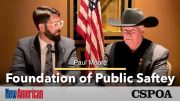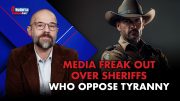
On Saturday, Kanab, Utah, was the site of the funeral of LaVoy Finicum, the Arizona rancher killed by federal agents at a traffic checkpoint near the Malheur Wildlife Refuge in Oregon he was occupying along with several other protesters.
In advance of the services, the the Utah Statewide Information and Analysis Center — a federal/local fusion center — issued a bulletin preparing law enforcement officials for potential “armed extremists” that could be traveling through the Beehive State on their way to show their final respects to Finicum and his family.
As The New American has reported, fusion centers are intelligence-gathering agencies located at local police precincts and paid for by the federal Department of Homeland Security. At the centers, federal agents cooperate with local law enforcement in the gathering and sharing of surveillance data.
The following information is taken from a fact sheet on fusion centers posted on the DHS website: “A fusion center is a collaborative effort of two or more agencies that provide resources, expertise and information to the center with the goal of maximizing their ability to detect, prevent, investigate, and respond to criminal and terrorist activity.”
A description of the functioning of these incubators for the forthcoming federal police force is also provided on the DHS site:
State and major urban area fusion centers (fusion centers) serve as primary focal points within the state and local environment for the receipt, analysis, gathering, and sharing of threat-related information among federal, state, local, tribal, and territorial (SLTT) partners…. Fusion centers conduct analysis and facilitate information sharing, assisting law enforcement and homeland security partners in preventing, protecting against, and responding to crime and terrorism.
The federal surveillance outpost in Utah informed the state’s law enforcement that these “domestic extremists” often display “visual indicators” they state are “associated with their extremism.”
Among these indicators is the Gadsden Flag (shown) and the logo of the Oathkeepers, an organization composed of veterans and active-duty military members committed to upholding the Constitution.
To keep Americans safe from this “potential threat toward LE [law enforcement] or to the public safety,” the Salt Lake City fusion center promised to remain “in contact with fusion centers in surrounding states to facilitate information sharing regarding the upcoming events.”
Undoubtedly, that information will include any data collected on these “these potentially volatile persons” by the various surveillance systems available to agents of the federal surveillance state who are in command at these fusion centers.
The literature promoting the acceptance of fusion centers lists several ways the new federal agency will impose its will on the formerly autonomous and accountable police chief or county sheriff.
In 2012, this reporter penned an article for The New American that described the likely procedure:
First, the feds will decide where and when to deploy local police department personnel. The chief, if he still exists, will be no more than a functionary required to make sure that the orders of the federal government are carried out. More likely than not, these new missions, in addition to preventing crime in the city or county, will engage in the collection of information about and apprehension of those local citizens identified by a committee in Washington as posing a threat to national security. Consider the revelation in 2009 that Homeland Security’s Office of Intelligence and Analysis released a document entitled “Rightwing Extremism: Current Economic and Political Climate Fueling Resurgence in Radicalism and Recruitment,” which listed war veterans, anti-abortion activists, small-government advocates, and those concerned about immigration as terrorist risks.
Second, DHS (or whichever one of the federal agencies eventually takes over law-enforcement duties) will train new recruits. Policies, procedures, and purposes will not reflect traditional (and constitutional) goals of law enforcement, but will be tailored to training officers to perform those duties associated with the new, national emphasis of the force, with a slant toward federalism.
Finally, funds for this conversion from local police department to outpost of the federal law-enforcement agency will be provided by the bureaucrats on Capitol Hill. This carrot will be tied to the stick of federal control.
Obviously, the type of profiling promoted by the Salt Lake City fusion center is dangerous and puts police on the street in the unenviable position of having to consider anyone with these “visual indicators” or ones like them to be a threat to public safety, thus requiring the officer to detain them regardless of the purpose behind the bumper sticker.
Reason magazine reported on the fusion center bulletin as well, and included a statement from an individual working in the security sector that sees in the bulletin’s instructions the potential for the violation of civil liberties of innocent citizens:
One private-sector security professional who received the bulletin worries that it could lead to a kind of profiling. “I work with a younng man, 24 years old, three associate’s degrees, volunteer fire fighter, dreams of becoming a police officer,” he says. “He’s also an Armenian-Russian immigrant who just earned his American citizenship. He sports a Gadsden flag on his car because of what it represents in our country’s history.” If a cop sees that car today, the security worker worries, the officer’s “thoughts will automatically flip to profiling him” as a violent extremist.
The Reason article also quotes former FBI agent Mike German, who believes the approach taken by the fusion center “is unhelpful because it is overgeneralized in describing a threat and lacking in any useful advice. It seems almost like CYA [cover your a**], so they can say ‘we warned ’em’ if anything bad happens.”
The fusion center agent who authorized the dissemination of this document should be reminded of the fact that there is not a single syllable of the Constitution authorizing any such federal participation in law enforcement. If the power isn’t granted to the federal government in the Constitution, then authority over that area remains with the states and the people as described in the 10th Amendment.
In many cities and towns there is still time to stop the march toward consolidation. State and local sovereignty is the solution. Constitutional sheriffs and conscientious police chiefs are the last line of defense of the traditional mission of American law enforcement and should be jealous of their responsibilities, and should never permit politicians to hand those duties over to companies, cabals, or federal agencies.
Citizens should be concerned about the consolidation, as it will result in their loss of direct control over their neighborhood law enforcement.
The further away law enforcement is from the direct involvement of the local citizen, the less responsive it becomes to the local citizen.
The Statewide Information and Analysis Center has not responded to this reporter’s repeated requests for comment on the bulletin.



